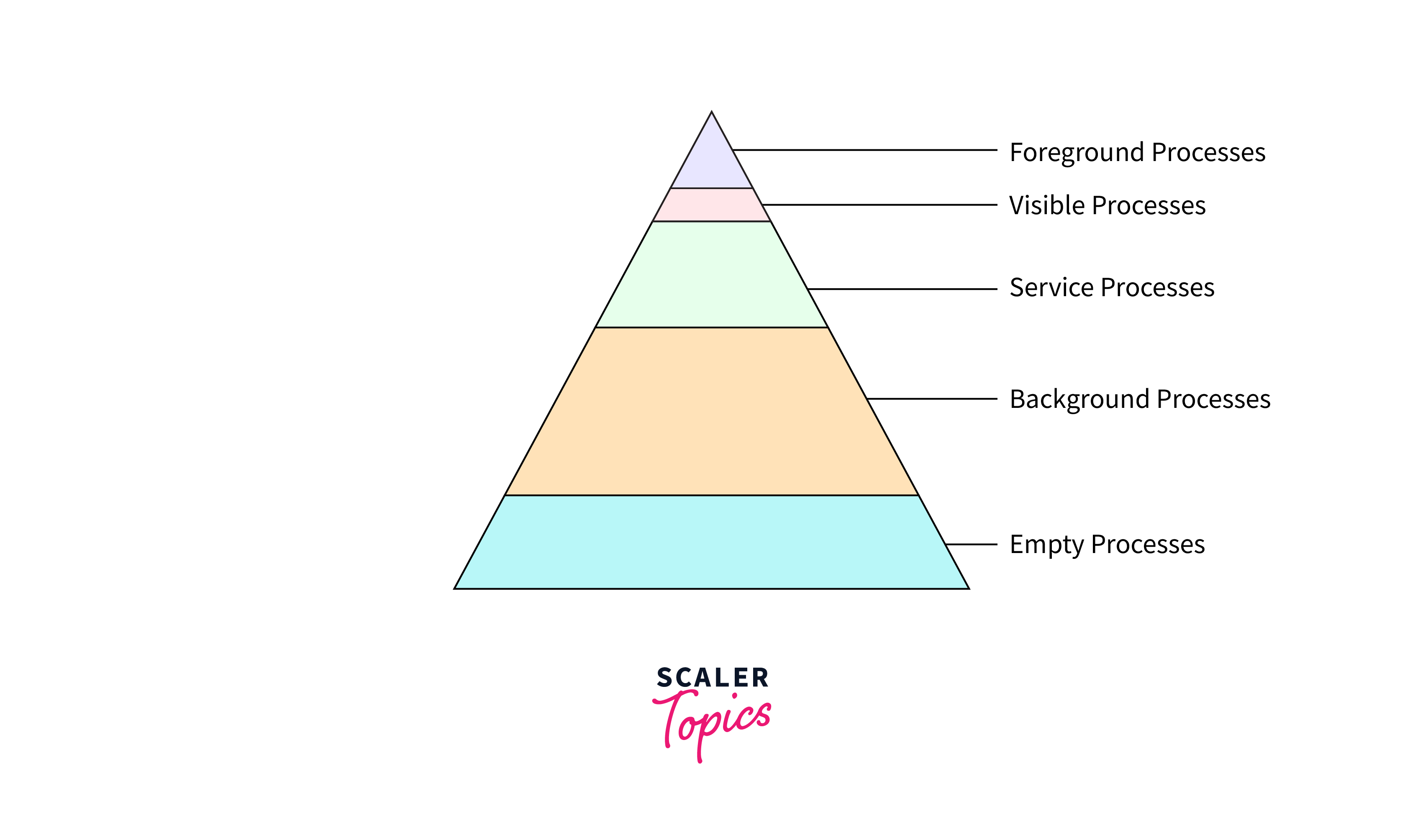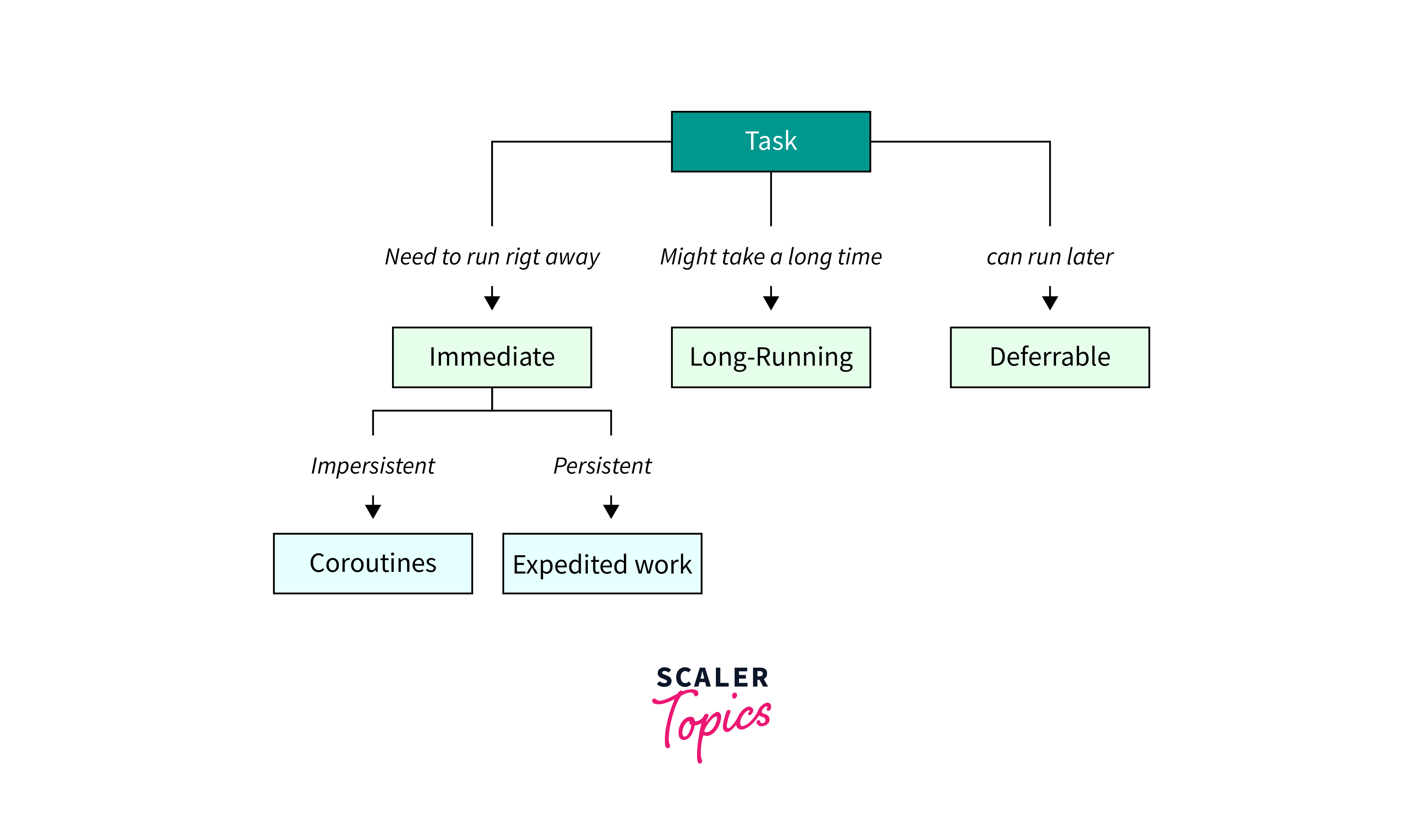Background Tasks in Android
Overview
Background tasks are vital in Android app development, allowing apps to perform operations in the background. The Main Thread, responsible for user input and UI updates, must be kept free from long-running operations to prevent unresponsiveness. AsyncTask, Handlers, and Services are used for background tasks. AsyncTask enables background operations with UI updates. Services, including IntentService, are used for long-running and one-time operations. Worker threads and Handlers facilitate communication between threads. Best practices include thread safety, resource management, and error handling. Background tasks can also be executed in the foreground when necessary. Libraries like RxJava, AsyncTask, and WorkManager provide convenient options. WorkManager and JobScheduler APIs offer powerful background task scheduling.

Understanding the Main Thread
The Main Thread is responsible for handling user input and updating the UI in Android apps. It shouldn't be blocked by long-running operations or blocking code to avoid freezing or unresponsive UI. AsyncTask or Handlers can be used to perform background tasks and update the UI from other threads. Properly managing the Main Thread is crucial for creating responsive and user-friendly Android applications with background tasks.
Introduction to the Main Thread (UI Thread)
The Main Thread is responsible for handling user input and updating the UI in Android apps.
Limitations of Performing Long-running Tasks on the Main Thread
- Unresponsive UI:
Long-running tasks can block the main thread, causing the UI to freeze and become unresponsive. - ANR (Application Not Responding) errors:
If the main thread is blocked for too long, the Android system can generate an ANR error, which can lead to app crashes or force closures. - Poor user experience:
Unresponsive UI and ANR errors can lead to a poor user experience, which can negatively impact user engagement and retention. - Battery drain:
Long-running tasks on the main thread can consume more battery than necessary, leading to increased battery drain and reduced device performance. - Inefficient use of resources:
Performing long-running tasks on the main thread can lead to inefficient use of system resources, such as CPU and memory, which can impact the performance of other apps running on the device.
Types of Background Tasks
In Android, there are three main types of background tasks: Services, Broadcast Receivers, and AsyncTask. Services are used to perform long-running operations in the background, such as downloading files or syncing data between apps. Broadcast Receivers are used to respond to system-wide events like incoming calls or SMS messages. Finally, AsyncTask is used to perform short-term background operations like updating data or downloading files.
Each of these background tasks serves a different purpose and can be used to create more responsive and efficient apps. However, it's important to balance the need for background tasks with the impact they can have on device performance and battery life. By understanding the different types of background tasks available in Android, developers can create apps that are both powerful and user-friendly.

Asynchronous Tasks with AsyncTask
- AsyncTask performs background operations and updates UI on the main thread in Android.
- It has four methods: onPreExecute, doInBackground, onProgressUpdate, and onPostExecute, which can be overridden for specific tasks.
Here is an example of using AsyncTask to download an image in the background and update the UI:
To use this task, you can create an instance of the task and execute it:
Background Services with Service and IntentService
- Service is a foundation class for constructing services that may operate in the background forever to perform long-running operations in Android.
- You can start a service by calling startService() and stop it by calling stopService().
- IntentService is a subclass of Service that handles asynchronous requests (intents) on a worker thread for one-time background tasks.
Here is an example of using IntentService to download a file in the background:
To start this service, you can create an Intent and call startService():
Worker Threads with Thread and Handler
Threads may be used in Android to do long-running activities in the background. Two classes that can be used to create and manage threads are Thread and Handler.
Thread is a class that represents a thread of execution. You can create a new thread by extending the Thread class and overriding the run() method, or by passing a Runnable object to the Thread constructor. Here is an example of using Thread to download a file in the background:
Handler is a class that allows you to send and process messages between threads. You can create a new Handler object in the main thread and use it to post messages to a worker thread. Here is an example of using Handler to update the UI from a worker thread:
In this example, the performLongRunningOperation() method is called in a worker thread, and the updateUi() method is called in the main thread using the Handler.post() method.
AsyncTask for Background Processing
AsyncTask is an Android class that allows you to do background activities and publish the results on the UI thread without having to deal with threads and/or handlers.
Background Services
Background services are a type of Android component that runs in the background, independent of the user interface. They are used to perform long-running operations, such as playing music or monitoring sensors, without interrupting the user experience. They can be started and stopped programmatically, and can also run independently of the app.
Creating a Background Service
an example of a background service in Android:
This service will run indefinitely in the background and log a message every second. It can be started and stopped using startService() and stopService() respectively.
Starting and Stopping a Service, and Communicating with it
To start and stop a service in Android, you can use the startService() and stopService() methods respectively. Here is an example:
To communicate with a service, you can use an Intent to send data to the service, and a BroadcastReceiver to receive data from the service. Here is an example:
In the service:
In the activity:
IntentService for Background Operations
IntentService responds to asynchronous requests on demand using startService(Intent). It processes each Intent, in turn, using a worker thread and terminates itself when it runs out of work. It offers a simple framework for conducting a single background thread activity. It manages long-running tasks without interfering with program responsiveness.
Worker Threads and Handlers
Worker threads perform long-running operations in the background, keeping the main thread responsive. Handlers communicate between the worker thread and the main thread, allowing UI updates after the operation is complete. By using both, you can avoid the "Application Not Responding" error and keep your app responsive. They are essential for performing background tasks in Android and are used extensively in Android development.
Background Task Best Practices
Understanding Thread Safety and Synchronization
- Thread safety and synchronization are important concepts in multithreading.
- Thread safety refers to the ability of a program to function correctly when multiple threads are executing simultaneously.
- Synchronization refers to the coordination of threads to ensure that they do not interfere with each other.
- Synchronization can be achieved using locks, semaphores, and other mechanisms that ensure that only one thread can access a resource at a time.
- It is important to ensure that your code is thread safe, especially when working with shared resources such as databases, files, and network connections.
Managing Memory and Resource Usage
- Use the appropriate threading model for the task.
- Avoid creating memory leaks by clearing references to objects when they're no longer needed.
- Use caching to reduce memory usage.
- Optimize network usage by batching requests and using compression.
- Use the appropriate type of storage for the data being used.
Handling Task Cancellation and Error Handling
- Provide a way to cancel the task and clean up resources.
- Use appropriate error-handling techniques such as try-catch blocks and logging.
- Use the appropriate type of exception for the error.
- Use the appropriate type of notification for the error.
- Provide clear and concise error messages to the user.
Executing Background Tasks in Foreground
- Executing background tasks in the foreground in Android can be useful in certain situations.
- It's necessary when a task requires user input or has a significant impact on battery life.
- It allows the user to monitor the progress of the task and provide input if necessary.
- However, it should be used sparingly as it can impact the user experience.
- It's best to follow best practices for background tasks in Android and execute tasks in the foreground only when necessary.
Background Task Execution Patterns
- Background task execution patterns in Android vary depending on the task type.
- Services are used for long-running tasks that don't require a user interface.
- Threads are used for short-lived tasks that require a small amount of processing time.
- AsyncTask is convenient to update UI in response to the task's progress.
- It's important to follow best practices for background tasks in Android to avoid user experience impact or other issues.
Background Task Libraries and APIs
Background task libraries and APIs provide a convenient way to perform background tasks in Android, with a variety of options available depending on the specific needs of the task.
Overview of Popular Libraries for Background Tasks
- RxJava provides a reactive programming model for handling asynchronous tasks.
- AsyncTask is a simple way to perform tasks in the background.
- WorkManager is a newer library that provides a flexible and powerful way to schedule and perform background tasks.
- WorkManager supports features like constraints and callbacks to help developers build more robust background tasks.
- Other popular libraries for background tasks in Android include Firebase JobDispatcher and JobScheduler.
- These libraries can help simplify the process of performing background tasks in Android, allowing developers to focus on building great apps.
Exploring Android's WorkManager and JobScheduler APIs
- WorkManager is a powerful library for scheduling and performing background tasks in Android.
- It provides a simple and consistent API for one-off and periodic tasks.
- WorkManager is built on top of JobScheduler, AlarmManager, and BroadcastReceiver.
- It supports features like constraints and callbacks to help developers build robust background tasks.
- WorkManager is designed to handle complex scenarios like network connectivity changes and device reboots.
- JobScheduler allows developers to schedule background tasks in Android.
- It performs tasks when device conditions are met, such as when the device is idle or connected to a power source.
- It's built into the Android operating system and is battery-efficient and reliable.
- JobScheduler can be used with other APIs like AlarmManager and BroadcastReceiver to create complex workflows.
Conclusion
- Background tasks in Android app development are crucial but must be implemented properly to avoid battery drain, performance issues, and negative user experience.
- The Main Thread should remain free from long-running operations to prevent UI unresponsiveness and ANR errors, utilizing techniques like AsyncTask and Handlers for background tasks and UI updates.
- There are two types of background tasks: periodic and one-time, which can be efficiently scheduled and performed using APIs like JobScheduler, WorkManager, and AlarmManager.
- AsyncTask offers a convenient way to execute short-lived background tasks and update the UI with methods like doInBackground and onPostExecute.
- Background services, such as Service and IntentService, handle long-running operations, with Service running indefinitely and IntentService handling one-time tasks. They can be controlled programmatically and operate independently of the app.
